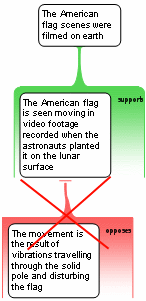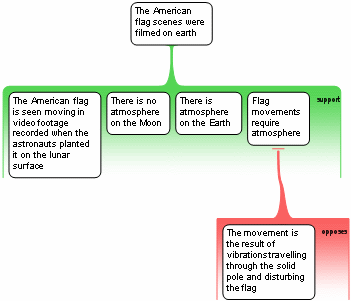
 |
|
|
|
|
| 5.4 Mapping Inference Objections | |
In a completed argument map, every inference objection has become an objection to some co-premise.
The main challenge in mapping the inference objection is identifying the appropriate co-premise.
| Discussion |
Another way to put this point is that every objection to an inference is also an objection to an assumption which helps connect the other premise(s) to the main contention. That assumption can be expressed as a claim, and then the objection can be targeted on that claim.
Thus, to produce an argument map of an inference objection, follow these steps:
(Note that step 2 will only apply if the inference objection is in fact relevant to the reason. If it is completely misplaced, it might not be an objection to any co-premise.)
Example:
 We saw previously that this objection was not targeted on the stated premise; it was an inference objection. |
 The inference objection is in fact a premise objection - though to a premise which was previously hidden. |
Why do inference objections exist? Because most of the time people have not fully elaborated their arguments. Since many premises have been left unstated, objections to those (unstated) premises have nothing to be directly targeted upon. It will appear that they are objecting to the inference rather than to the current premises. In a sense that is right; that is what they are doing. However you will always find that, in a properly articulated argument map, a previously-hidden premise will come to light, and the objection will provide evidence against that premise.
| Glossary | Contents | |
|
Copyright © Critical Thinking Skills BV - |
|